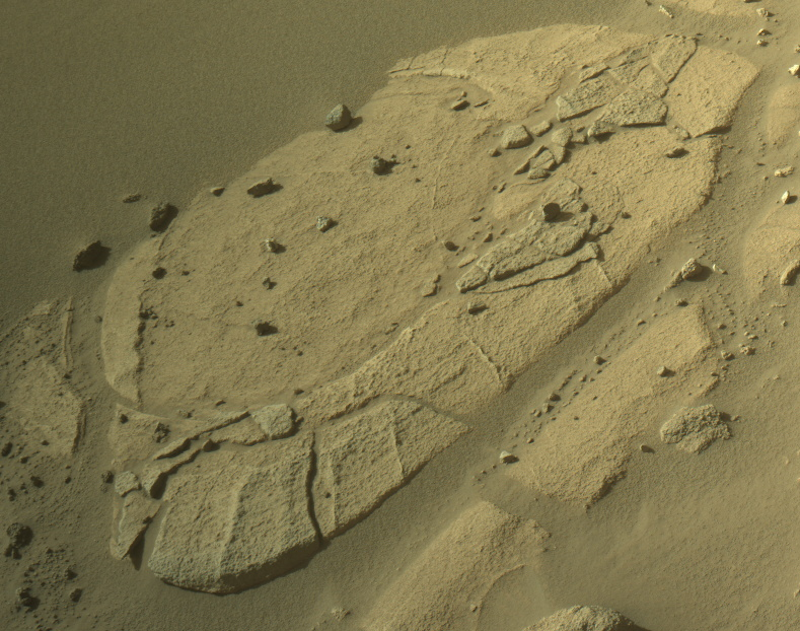
Rock features on Mars raise questions
Was there ever life on Mars? After 21 Mars landers, and a host of spacecraft observing from orbit, we still don’t know. The search of past Martian life has focused primarily on biosignatures – chemical evidence in rocks, or in the air – left behind by once-living microorganisms. Those sorts of clues need to be puzzled out in laboratory analysis. But what if we could see telltale signs of biology in Mars’ rocky landscape? The Mars rovers have sometimes seen tantalizing and unusual shapes or other features. Mostly, these have been explained as erosion due to Mars’ thin atmosphere. But on September 27, 2023, the Perseverance rover came across another oddity: circular formations that resemble those made on Earth by microbes in some lakes.
The jury is still out, but let’s take a look.
Space journalist Leonard David, in his blog Leonard David’s INSIDE OUTER SPACE, wrote about the finding on November 5, 2023. NASA released the images recently as part of the daily upload of new images from the rover. There’s no published analysis or paper yet, so right now we just have the images and comments from scientists on the mission team.
The 2024 lunar calendars are here! Best Christmas gifts in the universe! Check ’em out here.
Unusual rock features on Mars
The rover has been exploring the remains of an ancient delta in Jezero crater. This is where a river once flowed into the lake that existed inside the crater billions of years ago. The delta is still clearly visible from above. NASA sent Perseverance to Jezero crater specifically for this reason, as it would be an ideal location to search for evidence of past microbial life.
As noted above, that search is mostly about looking for traces of biosignatures that originated from microbes. To be sure, the rover has already discovered abundant organic molecules in the samples it has tested in its onboard laboratory. However, this isn’t proof of past life yet. That will likely require – if any life did actually exist – getting some of those samples back to Earth to study in more advanced labs.
Several weeks ago, Perseverance came across something intriguing: circular formations of rock with concentric curves. They seemed to resemble similar formations on Earth called stromatolites and microbialites. They are created by microbial communities in some lakes, in a process combining biology and geology. Could it be? Perseverance did land in an ancient lake bed … The Great Salt Lake in Utah has some great examples of stromatolites. On Earth, they are created by a combination of bacteria and calcium carbonate. They also resemble reefs, but are not actually made of coral. Could a similar process have happened on Mars?
Mars Guy
Steven Ruff, a Mars geologist at Arizona State University, weighed in on the discovery on his YouTube channel Mars Guy. As quoted in the blog post by Leonard David, Ruff said:
In the very place it might be reasonable to expect, Perseverance discovered circular rock structures resembling ones formed by microbial communities in some lakes on Earth. This exciting possibility called for a closer look.
In this video, Steven Ruff, a Mars geologist at Arizona State University, discusses the discovery of the interesting circular formations and what they might be. Video via Mars Guy/ YouTube.
Biology or no biology?
The formations do resemble stromatolites, or even more specifically, microbialites. There’s another possibility, however, as Mars Guy pointed out in the video. It’s called spheroidal weathering. That is when chemical weathering affects jointed bedrock and results in the formation of concentric or spherical layers of highly decayed rock. This produces concentric “shells” of rock, kind of like the layers of an onion. These also have a similarity to the features seen on Mars. Leonard David quoted Kenneth Farley, a geochemist at the California Institute of Technology. He said:
We investigated that rock with our remote sensing instruments, and we acquired two abrasion patches and two sample cores from similar rocks in close proximity. We also recognized the very peculiar and suggestive concentric-domelike morphology.
David also said:
Farley said as an alternative to a biological origin – for example, a stromatolite – Mars scientists on the rover mission also considered the hypothesis that these features are simply spheroidal weathering. That’s a very common phenomenon on Earth, Farley pointed out, and one seen elsewhere in Jezero, in both igneous and sedimentary rocks.
Farley added:
Although we are still interpreting the data, the latter hypothesis is far less extraordinary, and at least partly for this reason, currently favored.

Could the Perseverance rover recognize visible signs of life?
This brings us back to the question of whether Perseverance could recognize visible signs of past life, such as those produced by microbes. Farley answered, saying:
My answer is ‘maybe.’ Based on ancient terrestrial analogs, there are plausible manifestations we could detect with our instrument suite, but many plausible manifestations too subtle for us to confidently identify. This is, of course, a key motivation for sample return. As an example, compared to the organic molecule detection capabilities on Perseverance, those in terrestrial laboratories are at least a factor of 10,000 more sensitive.
It will be interesting to see if Perseverance comes across any more similar features in its travels, or even the Curiosity rover in Gale Crater.
Bottom line: NASA’s Perseverance rover recently found some odd circular formations on Mars, similar to ones made by microbes on Earth in lakes. Evidence of life or geology?
Via Leonard David’s INSIDE OUTER SPACE
Read more: Dragon bones on Mars? Curiosity spies weird rocks











